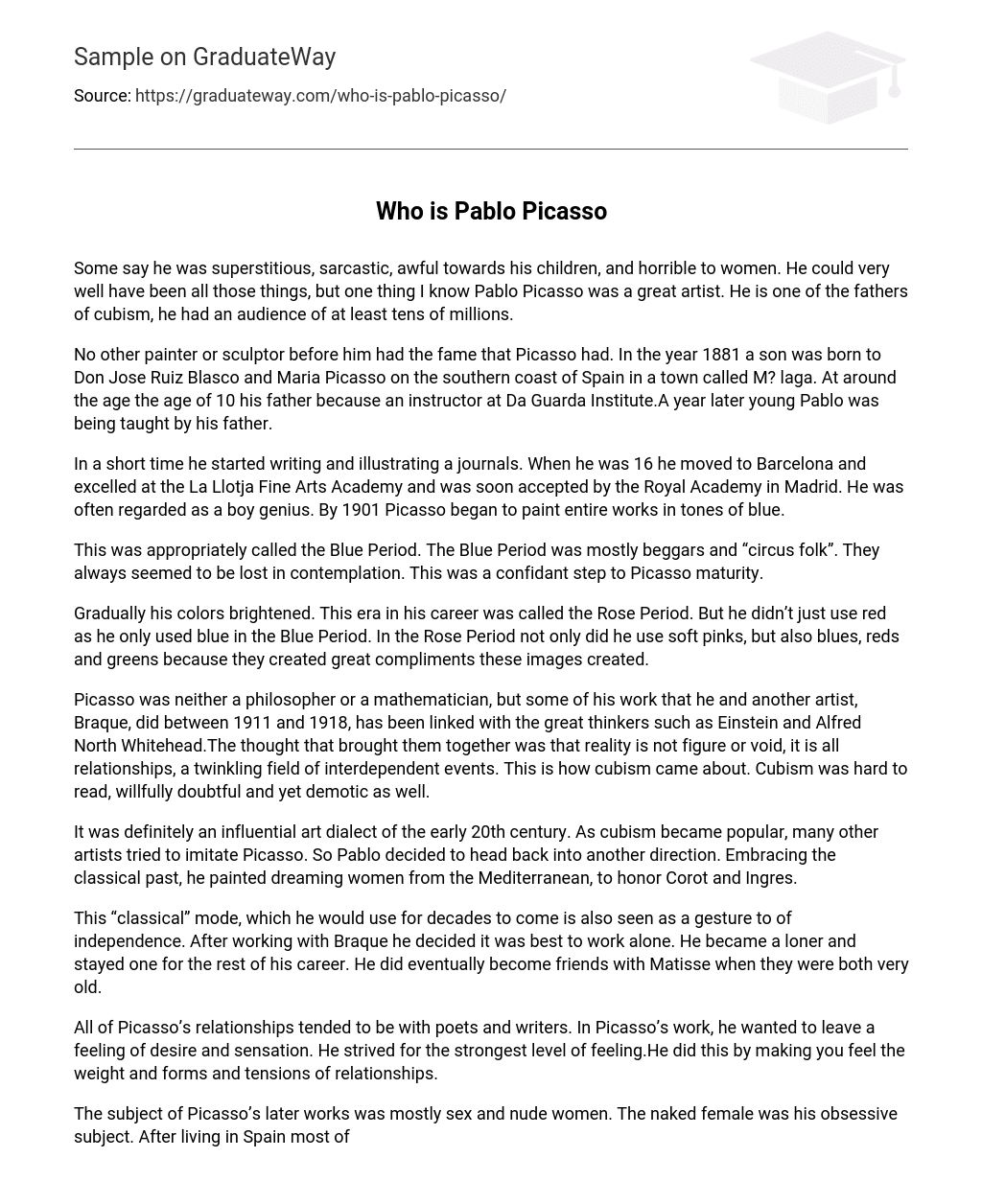Some say he was superstitious, sarcastic, awful towards his children, and horrible to women. He could very well have been all those things, but one thing I know Pablo Picasso was a great artist. He is one of the fathers of cubism, he had an audience of at least tens of millions.
No other painter or sculptor before him had the fame that Picasso had. In the year 1881 a son was born to Don Jose Ruiz Blasco and Maria Picasso on the southern coast of Spain in a town called M? laga. At around the age the age of 10 his father because an instructor at Da Guarda Institute.A year later young Pablo was being taught by his father.
In a short time he started writing and illustrating a journals. When he was 16 he moved to Barcelona and excelled at the La Llotja Fine Arts Academy and was soon accepted by the Royal Academy in Madrid. He was often regarded as a boy genius. By 1901 Picasso began to paint entire works in tones of blue.
This was appropriately called the Blue Period. The Blue Period was mostly beggars and “circus folk”. They always seemed to be lost in contemplation. This was a confidant step to Picasso maturity.
Gradually his colors brightened. This era in his career was called the Rose Period. But he didn’t just use red as he only used blue in the Blue Period. In the Rose Period not only did he use soft pinks, but also blues, reds and greens because they created great compliments these images created.
Picasso was neither a philosopher or a mathematician, but some of his work that he and another artist, Braque, did between 1911 and 1918, has been linked with the great thinkers such as Einstein and Alfred North Whitehead.The thought that brought them together was that reality is not figure or void, it is all relationships, a twinkling field of interdependent events. This is how cubism came about. Cubism was hard to read, willfully doubtful and yet demotic as well.
It was definitely an influential art dialect of the early 20th century. As cubism became popular, many other artists tried to imitate Picasso. So Pablo decided to head back into another direction. Embracing the classical past, he painted dreaming women from the Mediterranean, to honor Corot and Ingres.
This “classical” mode, which he would use for decades to come is also seen as a gesture to of independence. After working with Braque he decided it was best to work alone. He became a loner and stayed one for the rest of his career. He did eventually become friends with Matisse when they were both very old.
All of Picasso’s relationships tended to be with poets and writers. In Picasso’s work, he wanted to leave a feeling of desire and sensation. He strived for the strongest level of feeling.He did this by making you feel the weight and forms and tensions of relationships.
The subject of Picasso’s later works was mostly sex and nude women. The naked female was his obsessive subject. After living in Spain most of his life, Picasso decided to move to Paris. In the second move there (to Paris), he lived with Max Jacob and was very poor.
He soon moved back to Spain. But the lure of Paris brought him back. He lived in France for most of his life, and he died in Mougin, France in 1973 at the old age of 93.He had two children by 2 different women.
He also left a huge impact on the art of the 20th century and for all the art to follow. Picasso’s fame protected him in many ways and a numerous amounts of times. When Germany took over France during World War II, his fame kept him from many harms. Also it kept him away from criticism, during the Cold War era, in America even though he openly endorsed Joseph Stalin.
His artwork is still always being studied and debated over. Picasso knew to fascinate the human mind with his paintings.





